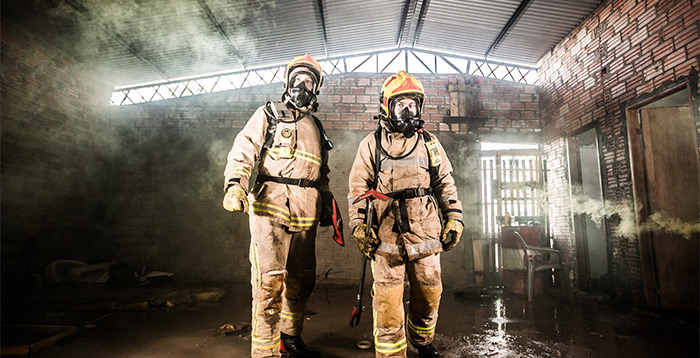Fire and Smoke Damage
Most modern building materials are highly resilient to burning – brick for example, having already been fired, has a good level of resistance. Concrete is extremely fire resistant because it’s made entirely of inert materials. It has not yet been observed to combust, but with prolonged exposure to heat, concrete can crack or become seriously compromised, and the same goes for brick. This can be made worse by the rapid contraction caused by dousing in cold water while the fire is fought. Steel reinforcement can warp or buckle, damaging concrete even further and rendering a building unsafe.
Structurally, a lot can go wrong after a fire – the building itself may not be salvageable.
As for smoke damage, it isn’t simply a cosmetic factor; soot can be harmful to health and requires rigorous cleaning. It can penetrate and damage drywall beyond cleaning and, while it won’t do structural damage, can ruin the entire contents of a building. It’s surprising what can be damaged – but also what can be saved.
Carpets and upholstery, for example, can be salvaged if the fire and water damage to them are minimal. They’ll require special cleaning methods, but they could be restored. Smoke damaged furniture, even if it’s partially burned or blistered, can be restored to pre-loss condition, even if it requires reupholstering. Porcelain and metal surfaces (like the stainless steel on appliances or work surfaces) can be cleaned – but plastics and PVC stain very easily, and may not be salvageable, especially if they’ve melted out of shape.
The Restoration Process
Restoring a building after a fire is challenging. Sometimes, the whole structure will have to be demolished. In that case, the only items that can be salvaged are the remaining raw scrap materials. The process fire varies – it can be extremely complex in historic buildings, where materials and skills are in short supply – but a general structure fire has a roadmap that results in either restoration or demolition.
Survey
A full survey will be required to assess the viability of the building. Structural damage must be accurately logged, as well as exposure of asbestos or other chemicals that could cause harm. Nothing can progress until the building is deemed safe to restore – and if it’s not, it’ll be condemned to demolition.
Secure
If the building is safe to enter and work on, then the next step is security – and not just to prevent people from entering. A fire damaged building is susceptible to further damage from rain, leaking pipes or electrical shorting from newly exposed wires. Preventative measures must be taken to prevent further loss.
Salvage and Cleanup
Next comes cleanup, which can be arduous. Typically, the first step is drying, undoing the damage caused by putting the fire out or by ruptured water pipes. Drying relies on airflow, heat and dehumidification, and industrial dehumidifiers are usually deployed to speed the process up. Fast-drying is essential to avoid mould, damp and rot setting in.
While drying takes place, salvage and removal can begin. Items that can be cleaned or restored are set aside in storage, while permanently damaged contents are disposed of.
Once dried out, the damage from smoke needs to be dealt with. Soot and odours can be removed by scrubbing, washing and chemical treatments – but some items might not make it through this process.
At the end of salvage and cleanup, the building should be completely empty, dry and clean – but it may now be missing drywall, flooring, rendering, paint and lighting.
Restore or Remodel
Now, it’s time to get the building back to operating status. Refinishing and repainting give an opportunity to remodel the building and give it a new lease of life, or to restore things almost exactly as they were. It’s also an excellent opportunity to consider the installation of non-intrusive fire and smoke curtains.
Fire and Smoke Curtains Save Lives and Structures
Coopers Fire is a leader in fire safety. We manufacture industry-leading fire curtains and provide educational training courses and consultancy. Save lives and buildings, with fire and smoke curtains. To learn more, call us on 02392 454 405 or email info@coopersfire.com.


